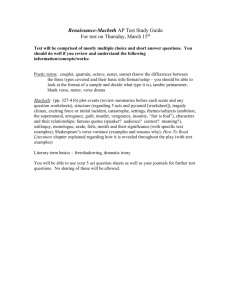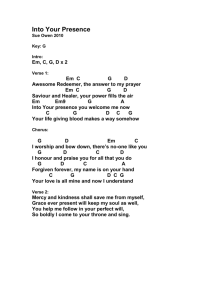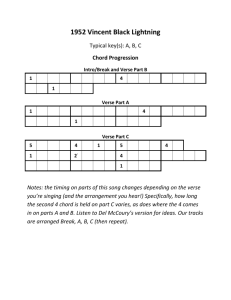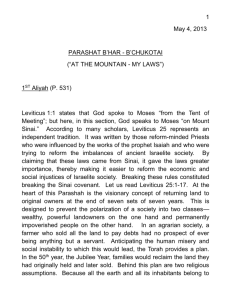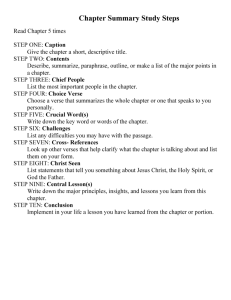Vayikra - Temple Beth El of Quincy
advertisement
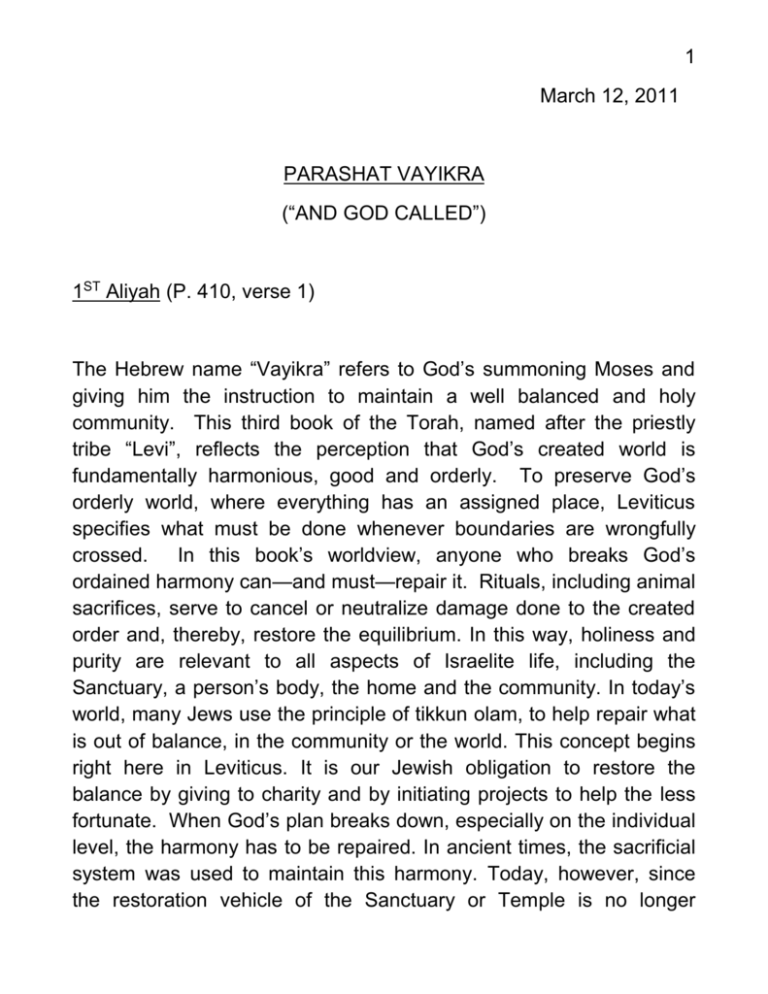
1 March 12, 2011 PARASHAT VAYIKRA (“AND GOD CALLED”) 1ST Aliyah (P. 410, verse 1) The Hebrew name “Vayikra” refers to God’s summoning Moses and giving him the instruction to maintain a well balanced and holy community. This third book of the Torah, named after the priestly tribe “Levi”, reflects the perception that God’s created world is fundamentally harmonious, good and orderly. To preserve God’s orderly world, where everything has an assigned place, Leviticus specifies what must be done whenever boundaries are wrongfully crossed. In this book’s worldview, anyone who breaks God’s ordained harmony can—and must—repair it. Rituals, including animal sacrifices, serve to cancel or neutralize damage done to the created order and, thereby, restore the equilibrium. In this way, holiness and purity are relevant to all aspects of Israelite life, including the Sanctuary, a person’s body, the home and the community. In today’s world, many Jews use the principle of tikkun olam, to help repair what is out of balance, in the community or the world. This concept begins right here in Leviticus. It is our Jewish obligation to restore the balance by giving to charity and by initiating projects to help the less fortunate. When God’s plan breaks down, especially on the individual level, the harmony has to be repaired. In ancient times, the sacrificial system was used to maintain this harmony. Today, however, since the restoration vehicle of the Sanctuary or Temple is no longer 2 available, the Rabbis have substituted the sacrifices with prayer, moral obligation, study and mitzvoth. When Rabbi Yahan ben Zakkai was passing by the ruins of the Second Temple, he said to a colleague, “Be not grieved. There is another equally meritorious way of gaining atonement even though the Temple is destroyed. We can still gain atonement through deeds of loving kindness. For it is written (in Hosea6:6), Loving kindness I desire, not sacrifice.” As Jews we have to determine how we fit into God’s plan of holiness. 2nd Aliyah (Sha ne) (P. 413, verse 14) Leviticus is a difficult book for a modern person to read with full appreciation. Its main subject—animal sacrifice and ritual impurity— seem very remote from our own world. Yet almost half of the 613 mitzvoth of the Torah are found in Leviticus. The modern reader may be turned off by the sacrificial descriptions and rituals. As a matter of fact, modern men and women tend to be more spontaneous and less ritually orientated. Yet there is something deeply moving about performing a rite, especially one that has ancient origins and comes down to us from our ancestors, grandparents and parents. It is important for us to know that we are “doing it right”. Rituals, including proscribed prayers, tell us how to act and what to say when we cannot rely on ourselves to know what to do. Ritual is a way of giving a voice to our ultimate values. Each of us needs a sense of Holiness to navigate through the relentless secularity of our lives. For the Israelites of Biblical times, it must have been gratifying to know what to do when they wanted to approach God at crucial moments of their lives, in need or in gratitude. For us, too, it is equally gratifying to know how to cope with life’s events, struggles and life cycles. 3 Judaism has given us, a world view to use and follow so that our own lives can be meaningful. For the ancient Israelites and for much of the ancient Near East, the way to please God was through animal sacrifice. There is no need to apologize for these rituals since they were valid expressions of their times. Using the ideas behind these ancient rituals, Judaism has continually updated itself to live and thrive in the modern world, but its roots are right here in Leviticus—so pay attention to its pages! 3rd Aliyah (Shileshe) (P. 414, verse 7) The first portion discusses “olah”, which is the Hebrew name meaning, “to go up” and it expresses the idea that the entire offering “goes up” to God as smoke, the substance into which the animal has been transformed by fire. The burnt offering is unique because all of it must be burned, except for the skin. The English term, “Holocaust” originally referred to this sacrifice. The text makes no mention of the purpose of the ritual. The idea, however, seems to be that this gift of life belongs completely to God—who gives life. It may express a recognition that a part of what one has received from God must return completely to God. The fact that the burnt offering usually appears first in a series of sacrifices suggests that its purpose may be to open up communications with the Divine. If so, then that goal would be accomplished by showing generosity—giving part of one’s wealth to God. Some of our present views of tzadakah originate in this part of Leviticus. This section also mentions the mincha or meal offering. The mincha offering includes: semonola or the choice sifted granules from ground wheat kernels, olive oil, and frankincense. A poor person can substitute this offering for more costly offerings. In matter of fact, the 4 Talmud comments “that when poor people bring an offering, however meager, God credits them as if they offered their own souls.” Abraham Kook, a chief Rabbi of Palestine, envisioned a time when the Temple would be rebuilt and only the grain offering would be brought, so that no animal would be slaughtered in God’s name. That sounds good to me! 4th Aliyah (Rivee) (P. 415, verse 1) This chapter deals with the third type of offering or zevah, in the Israelite worship. It is the offering of “sh’lamin” or well-being. The zevah sh’lamin is always given by an individual and never communal. It is an offering of gratitude and well-being. It is called “sh’lamin” from “shalem”, which means “whole” and from “shalom”, which can mean “harmony”. It is motivated not by guilt or obligation but by a sense of wholeness in the donor’s life or a sense of being at peace with one’s family, with the Priests of the Temple and with God. One commentator believes that the name derives from the fact that “it brings peace between the individual and neighbors who are invited to join the feast”. Not all the sacrifices were meant to atone for guilt. The first major categories of offerings were motivated by profound reverence and overflowing happiness. Later injunctions of the Torah imposed the rule that the sh’lamin had to be eaten on the day that it is brought or the following day, at the latest, and that it must be discarded by the morning of the third day. This was to encourage the donor to invite more friends and to allow poor people to join the celebration. The sense of joy increased with the number of participants. Many of the sacrifices were social events and served to unite not only the family but the community itself. During holiday 5 celebrations the sanctuary was crowded with thousands of pilgrims, who brought their animal and grain sacrifices. These sacrifices were popular with the people. Not only did it offer the people a way to communicate with Adonai (nigh) but it became a social event, in which people met and shared not only food but news and stories with each other. It was an expression of their world. 5th Aliyah (Ha meshe) (P. 417, verse 1) The name of the sacrifice, mentioned in this portion, is “chatat”. It derives from the same root as the word, “chet” or “sin”. It means, “That which cancels out sin”. The chatat is for any accidental—not deliberate—violation of certain ethical or ritual prohibitions. The person who brings the chatat then shall be forgiven. This offering takes different forms depending upon the social status of the transgressor. The different steps indicate greater degrees of responsibility and culpability, with infractions by Priests being subject to the most stringent procedures. The rules emphasize accountability rather than privilege. Impurity of the Priest in charge of sacrificial rituals puts everyone at the greatest risk because his impurity infects the Sanctuary most directly. This concept of greater culpability based on a person’s position, is needed in today’s world, especially in our own country. The decisions of our political, religious, industrial and economic leaders have great impact on the lives of the community. When they sin, the entire nation if not world is affected. This has been quite apparent in the lives of many Americans, who are suffering from the greed of the bankers, stockbrokers and politicians. If the Temple were in operation today, there would be an overabundance of bulls being sacrificed to God. The most current terminology replaces the 6 terms “sin” and “guilt” with the words “purgation” and “reparation”. The terms better capture the function of these offerings—the purgation offering clears away the damaging substances and the reparation offering reconstructs or restores the system to its harmonious wholeness. Our political, economic and business leaders have to be willing to bring chatat to the altar of God and be willing to admit their responsibility in creating spiritual and even physical danger to the community. 6th Aliyah (She she) (P. 419, verse 27) Sublimation of aggression, according to Janet Marder of the Women’s Commentary, may, in fact, underlie the entire sacrificial system of worship. A korban, an offering to God, is more than an act of violence. It is violence transmitted into something higher; it is God reshaping a destructive human drive into productive creative energy. Through bringing offerings to the altar, the fierce passions of the ego are not indulged but controlled and transcended. Animals, valued possessions and markers of wealth, are given selflessly to God—and thus the worshipper learns gradually to overcome greed. Animal blood is dashed on the altar, but human blood may not be shed. Substitution trains the worshipper to restrain his/her own innate savagery. A Chasidic commentator once said, “One who wants to become close to God—must bring an offering—that is from oneself”. What is the offering? It is the beast within ourselves—the part of ourselves that is capable of cruelty and brutality, even to those we love. The ritual of animal sacrifice, understood symbolically, conveys the struggle of flawed human beings in order to attain closeness to the Divine—to experience what we, today, would call spiritual 7 elevation, a consciousness of being lifted up to something higher than themselves. From the rituals of worship set forth in Vayikra, we learn that our yetzer hara may be channeled into constructive directions and be employed for the good. If we closely read the seemingly dry instructions and bloody details of animal sacrifice, we learn that through the discipline of our faith, we can redeem what is broken and flawed within ourselves, transforming barbaric urges into opportunities for blessing. 7th Aliyah (Shive e) (P. 421, verse 11) You are the Open Door That beckons me in; Peeking around the door frame I begin to enter into your glory. (The first stanza is from a poem by Debbie Perlman) In the ancient world, the way through the Open Door was the sacrificial system. It was the expected and accepted method to reach out to God. The system was done with respect, seriousness, communal awareness, satisfaction and great joy. Today, Judaism has changed and has developed different methods to open “the Door to God”, as the poem states. New ways, prayers, celebrations developed to communicate with God and to repair the world. For us, going back in time is not acceptable; but re-shaping ancient Judaism to fit the modern mindset, while still keeping with traditional values, is 8 an on-going process. Sacrifice was appropriate for its time but we now are in a new era, in which we have re-shaped Judaism, based on its past sacred traditions, for the benefit of ourselves and the world. What are some of the ways we can “Open the Door to God”? To continue with the poem: You move me forward, O Eternal To step beyond self- made boundaries; Lift my foot over the threshold That I might abide with You. In the house of the Eternal, I found my questions; Waiting to be posed, They fill me with wonder. Through the doorway of the Eternal Jumbled sounds and mingled scents; Warm sunlight falls across my lap: All this, Your creation. Sit with me Eternal Teacher, Encourage my seeking; AS I fill my hours with Your mitzvoth, 9 So shall I be filled. Then send me through Your door Stretching up to honor Your Name, Sharing out this wonder, Enriching myself in the giving. Maftir (P. 423, verse 24) Haftorah (P. 424) Ya-amode, ya-mode, Ben ben Moshe, Maftir Chazak or: Ya-amode, ya-amode, Ele-e-zar ben Daveed v’Shrona, Maftir Chazak


